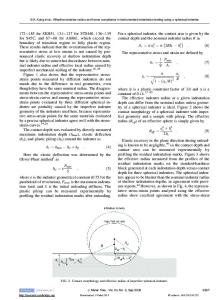Analysis of depth-sensing indentation tests with a Knoop indenter
- PDF / 214,152 Bytes
- 8 Pages / 612 x 792 pts (letter) Page_size
- 10 Downloads / 432 Views
T.J. Bell and A.C. Fischer-Crippsa) CSIRO Division of Telecommunications and Industrial Physics, P.O. Box 218, Lindfield, NSW 2070, Australia (Received 6 September 2000; accepted 21 March 2001)
The present work shows how data obtained in a depth-sensing indentation test using a Knoop indenter may be analyzed to provide elastic modulus and hardness of the specimen material. The method takes into account the elastic recovery along the direction of the short axis of the residual impression as the indenter is removed. If elastic recovery is not accounted for, the elastic modulus and hardness are overestimated by an amount that depends on the ratio of E/H of the specimen material. The new method of analysis expresses the elastic recovery of the short diagonal of the residual impression into an equivalent face angle for one side of the Knoop indenter. Conventional methods of analysis using this corrected angle provide results for modulus and hardness that are consistent with those obtained with other types of indenters.
I. INTRODUCTION
Indentation testing on the submicron scale enables convenient measurement of the mechanical properties of thin films and very small volumes of materials. Usually, the principal goal of such testing is to extract elastic modulus and hardness of the specimen from experimental readings of indenter load and depth of penetration. The methods of determining the area of contact from depth measurements, and hence hardness, and extraction of modulus from the unloading response are founded upon the elastic equations of contact of Hertz and also Sneddon.1– 6 The methods rely on the analysis of the shape of the elastic unloading curve following elastic plastic contact between an indenter and a specimen. The most common indenter geometries used are the threesided Berkovich indenter, the four-sided Vickers indenter, and the spherical indenter. These indenters have some degree of geometrical symmetry about them that is not shared by the less commonly used Knoop indenter. The Knoop indenter has an elongated four-sided pyramidal geometry that has the advantage of providing very shallow depths of penetration and the ability to respond to differences in the ratio of hardness to modulus of the specimen material. This response manifests itself in the relative sizes of the lengths of the diagonals of the
a)
Address all correspondence to this author.
1660
J. Mater. Res., Vol. 16, No. 6, Jun 2001
residual impression. In the present work, we show how the more commonly used methods of analysis (e.g., multiple-point unload 4 and single-point unload methods5) may be modified to apply to load and depth data obtained with a Knoop indenter. The new method of analysis takes into consideration the elastic recovery of the specimen material during unloading which is assumed to be a function of E/H of the specimen material. Comparison with experimental data is presented to illustrate the theory. II. ANALYSIS OF LOAD–DISPLACEMENT DATA A. Berkovich indenter
The three-sided Berkovich indenter has an included face angle
Data Loading...










